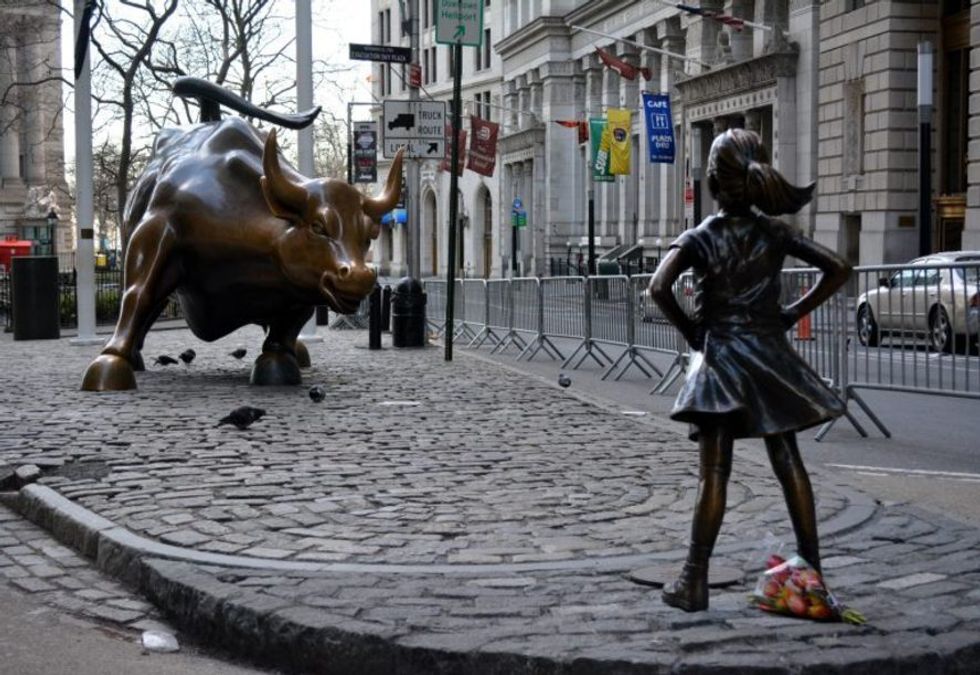On October 19, 1987, the largest contemporary global financial crisis struck its mark on history as 'Black Monday.'
Italian immigrant and artist Arturo Di Modica spent the next two years sculpting his infamous "Charging Bull." On December 15, 1989, he and a few friends devised and executed a well-thought out plan to drop the bull in front of the New York Stock Exchange before sunrise. The next morning, the city of New York along with global media networks marveled at the enormous present left beneath the Christmas tree.
By the end of the day, the sculpture was removed and relocated to Bowling Green after pending administration. It still stands there today as a symbol of American prosperity and diversity. The Charging Bull even has its own website on which its main purpose is stated.
"Arturo Di Modica first conceived of the Charging Bull as a way to celebrate the can-do spirit of America and especially New York, where people from all other the world could come regardless of their origin or circumstances, and through determination and hard work overcome every obstacle to become successful. It’s this symbol of virility and courage that Arturo saw as the perfect antidote to the Wall Street crash of 1987."
Born and raised in Sicily, Di Modica chose to leave home and further his art career at Florence’s Academia Del Nudo Libero. He immigrated to the United States in 1973 and received the Ellis Island Medal of Honor in 1999 for his outstanding creativity behind the Charging Bull.
Arturo Di Modica with his infamous Charging Bull
After spending almost three decades attracting millions of tourists annually, the Charging Bull now faces a new challenge besides keeping the economy in a bull-market state.
Kristen Visbal was born and raised in Montevideo, Uruguay in 1962 and came to America to study at a handful of universities across the country. Unlike the Charging Bull, Visbal's Fearless Girl was commissioned by the State Street Global Advisers in celebration of the one-year anniversary of their Gender Diversity Index. The purpose of the Fearless Girl was to encourage Wall Street and other companies to hire more women to their boards and increase gender diversity.
Kristen Visbal (in gray) stands to the right of her Fearless Girl
On the day before International Women's Day (March 7, 2017), the statue was planted in the pathway of Di Modica's statue, facing the Charging Bull with her hands on her hips. Underneath, a plaque reads, "Know the power of women in leadership. SHE makes a difference." (SHE refers to both women in general and the fund's NASDAQ ticker symbol).
The statue was originally issued a permit allowing it to stay for a week, later extended to a month; but after the immense response it received from tourists and activists, it was recently announced that the Fearless Girl would remain in place until February of 2018.
While both artists faced the trials and triumphs of immigrating to the United States, the main foundation of this controversy lies in the fact that their statues stand for two completely different reasons.
Visbal is confident in the Fearless Girl and her representation of the gender gap on Wall Street. "The piece is pungent with Girl Power!"
However, Di Modica argues that Visbal's statue distorts his art and the message behind it. As stated above, he stands firm in his message of prosperity for Americans "regardless of their origin or circumstances."
Both send a powerful message of prosperity, but because they were created for two completely different political reasons, Di Modica believes the "advertising trick" has altered the dynamic of his work.
Whether a lawsuit against the city of New York will follow has yet to be announced.
What do you think about this controversy? Leave a comment below!




 Kristen Visbal (in gray) stands to the right of her Fearless Girl
Kristen Visbal (in gray) stands to the right of her Fearless Girl







 Photo by
Photo by 








